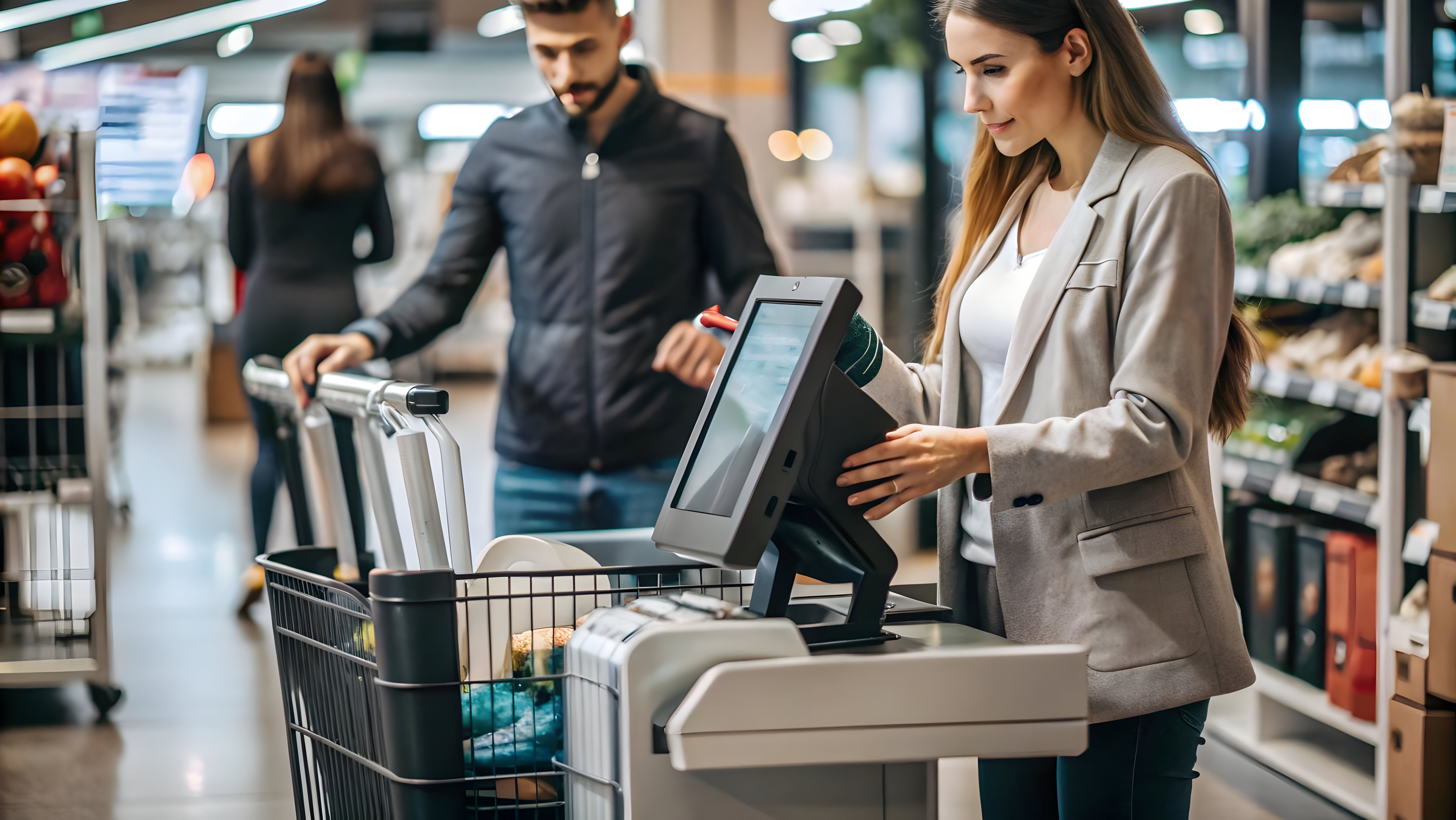The Benefits of Self-Checkout: Efficient Customer Journeys, Shorter Queues, and More
Self-checkout systems are revolutionizing the way consumers shop in supermarkets and other retail outlets.
Far beyond just saving time, they enhance store efficiency and redefine the customer experience.
Let’s explore in detail why these solutions are catching the attention of retailers and the various types available on the market.
What is self-checkout and how does it work?
Often found in supermarkets and large stores, a self-checkout system is an autonomous kiosk where the customer manages the entire payment process for their purchases.
The process is simple and intuitive: the customer scans the barcodes of their products using an integrated scanner and then proceeds with payment through methods accepted by the machine, which often include bank cards, mobile payments, and sometimes cash.
Why are retailers adopting self-checkout systems?
The benefits are numerous for both customers and merchants.
Customer benefits
Shorter queues
One of the most immediately noticeable advantages of self-checkout is the significant reduction in checkout wait times.
Long checkout lines are often seen as a source of frustration for customers. According to a study conducted by Harris Interactive for StrongPoint, about 76% of French shoppers have abandoned their in-store purchases due to excessively long queues (Source: GPO Magazine).
The deployment of self-checkouts in stores helps reduce these queues, as several customers can check out simultaneously.
There’s no need to wait for a cashier to be available.
This improves the shopping experience, making the process more fluid and seamless.
Fast payment
Self-checkout systems can reduce checkout time by up to 30%, according to the Retail Council of Canada (Source: fr.leav.co).
They are highly appreciated by consumers, especially during peak hours when queues can significantly hinder the shopping experience.
In fact, many customers say they prefer self-checkout, particularly for the speed and time savings it offers compared to traditional checkouts.
Ease of use
Payment through self-checkout is not only fast but also intuitive.
Self-checkout systems are designed to be easy to use. With clear interfaces and attractive screens, they guide the user step by step.
Even customers who are not particularly tech-savvy find using these machines a simple and stress-free experience.
This accessibility has helped expand the acceptance of this technology across all age groups.
Retailer benefits
Controlled purchasing process
For retailers, self-checkout systems offer greater control over the sales process.
These automated solutions play a key role in reducing human errors, such as incorrect scans, pricing mistakes, or double billing.
Moreover, with the advanced technology in these machines, self-checkouts eliminate concerns related to incorrect change. They count money and give change automatically, minimizing risks related to cash handling.
Secure transactions
Electronic Payment Terminals (EPTs) play a crucial role in securing transactions by incorporating cutting-edge technology to protect payment operations and reduce potential losses.
- Integrated security technologies: Self-checkout systems use weight sensors and advanced barcode readers. They accurately track products scanned during checkout.
These systems verify that the scanned items match those placed in the bag, reducing theft risks and improving stock management in-store.
- Optimized surveillance: Self-checkouts are often accompanied by video surveillance, providing full coverage of payment areas.
This solution deters theft and allows for monitoring of each transaction. Every checkout is recorded and visible, enhancing security for both consumers and staff.
- Reduced physical interactions: Self-checkout kiosks minimize contact between customers and employees, addressing safety concerns, particularly in a post-pandemic context.
This autonomy in the checkout process reduces the risk of disease transmission while offering customers a more reassuring and comfortable payment experience.
Self-checkout aims to improve customer service
It is becoming increasingly clear. Although automated, self-checkouts improve the customer experience.
They reduce friction during payment and speed up the shopping process, allowing customers to enjoy a more pleasant and less stressful shopping experience.
Additionally, by supplementing cashiers with machines, stores can reassign their staff to other roles—roles where human interaction adds real value, such as customer support.
Maximized space
And, as a bonus, self-checkout systems take up less space than traditional checkout stations. Retailers can better utilize their valuable store space.
This space can be used to showcase more products or create interactive promotional areas.
What are the different types of self-checkout systems?
As technologies evolve, self-checkout options are becoming increasingly varied.
Here’s an overview of the main types of self-checkout systems transforming the shopping experience today.
Electric charging kiosk with card payment
One of the most interesting and recent innovations in the field of self-checkouts is the electric charging kiosk with card payment.
These charging stations can be found in parking lots or gas stations, for example.
Before card payments, the kiosks offered limited and inconvenient options. Drivers often had to subscribe to specific services or use dedicated mobile apps.
The introduction of card payments simplifies the process.
Just like our PayOnsite payment terminal solution, drivers can now use the same card they use for everyday purchases.
This allows for quick and hassle-free payments.
Fixed self-checkout systems
These are the most common in supermarkets and retail stores.
Kiosks are located at specific points in the store. Customers scan their items, bag them, and pay through the machine.
Often, these systems include scales to verify the weight of the items and accept multiple payment methods: cash, credit cards, or mobile payments.
Mobile self-checkout systems
These solutions use mobile apps and smart carts. Customers download the store’s app, scan the products in real time, and pay directly through the app.
This eliminates the usual checkout procedures, making the shopping experience more seamless and personalized.
“Scan and Go” self-checkout solutions
This type of system allows customers to use handheld scanners or smartphones to scan product barcodes while shopping.
These solutions, often referred to as “Scan and Go,” drastically reduce checkout wait times.
Key takeaway:
Self-checkouts are game-changers. They speed up the purchasing process, reduce queues, and simplify payment.
For customers, it’s a smoother and faster experience.
For retailers, it’s better resource management and cost savings.
So, are you ready to transform the checkout experience at your store? Contact us! At Market Pay, we work to provide even more efficient solutions tailored to the needs of both consumers and retailers.





